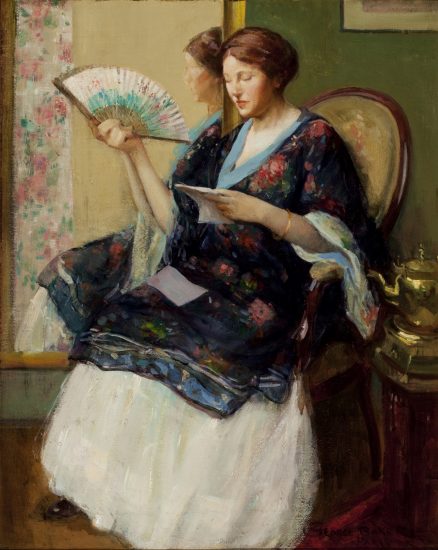- Categories
- Figural works
- Women
- Zoom in on Artwork
- Print Page
- Email Page to Friend
The young female model in George Oscar Baker’s The Chinese Coat is carefully posed, holding a letter in one hand and an oriental fan in the other. Close behind her upholstered chair, a tall gilt-edge mirror captures her gesture and reveals a swath of floral curtain. The reflective surface of the mirror is echoed at the lower right in the sheen of a polished teakettle set on a carved-wood stand. The corner of a framed picture at the upper right completes a setting that evokes both domesticity and refined aestheticism. It complements the woman’s luxurious dress: a black Chinese coat with a plunging neckline, embellished with pink flowers and a decorated hem below which cascades a white gathered skirt. This elegant but informal ensemble belongs in semi-private space. Baker shows his model intently reading a letter, the stamped envelope of which lies in her lap. Her eyes downcast, she is oblivious of the observer, yet her posture seems deliberately designed to display her graceful form and striking costume.
Baker’s painting pays homage to the art of Richard Emil Miller, his most important teacher. Miller was a prominent member of the American expatriate artists’ community in Paris when Baker studied with him at the Académie Colarossi, between 1907 and 1912. As Miller transitioned during those years from the dark tones of academic practice to the brighter color and loose brushwork of impressionism, Baker followed his lead. In the composition and the pose and costume of his model in this painting, moreover, he emulated a recent work by Miller, also called The Chinese Coat (location unknown), which was published in The Studio magazine in June 1911. Baker probably began painting his version shortly thereafter; it was one of his two entries in the 1912 American artists’ annual exhibition at the Art Institute of Chicago. Notwithstanding the close similarities between their paintings, the two artists appear to have worked from different models, wearing similar but not identical garments.
By the time Baker painted The Chinese Coat, the image of an attractive woman wearing a distinctive article of clothing for which the work is titled had become something of a cliché among American figural painters. Articles of dress and decorative objects with Far Eastern associations were particularly common in such works—for example, in the kimono and parasol featured in Pauline Palmer’s Untitled (Woman in a Garden). As both painted details and actual garments, these objects lent a note of exoticism that flattered the cosmopolitan tastes of well-to-do Americans at the turn of the twentieth century.
Wendy Greenhouse, PhD
Donated by M. Christine Schwartz to Lake Forest College, Lake Forest, Illinois, in 2021
